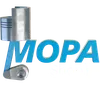Belt drive parts – efficient power transfer for engines
Belt drive systems are widely used in marine and industrial engines to transfer mechanical power from the crankshaft to auxiliary units such as alternators, pumps and fans. High-quality belt drive parts ensure smooth, quiet and efficient operation, even under variable loads and environmental stress. These components play a crucial role in system reliability and service life.
Choose from following:
Function and advantages
Belt drive parts enable flexible power transmission while absorbing shock and reducing vibration. Compared to gear or chain drives, belt systems offer easier maintenance and quieter performance. Key advantages include:
- Efficient energy transfer between engine and driven components
- Reduced wear and lower maintenance costs
- Compact, lightweight installation options
In marine engines and generators, belt-driven systems are essential for operating cooling water pumps, oil pumps, and charging systems.
Components and materials
A typical belt drive system consists of:
- Drive belts (V-belts, multi-rib belts, timing belts)
- Pulleys and tensioners
- Idlers and belt guides
Our belt drive parts are made from high-durability rubber, aramid-reinforced composites and corrosion-resistant metals. All parts are selected for compatibility with marine diesel engines and industrial units from manufacturers such as MTU, MAN, Deutz, MWM and Volvo Penta.
Applications and service
Belt drive systems are used in both propulsion engines and auxiliary machinery. In marine applications, proper belt tension and alignment are critical for reliable operation. Regular inspection and replacement of worn belt drive parts prevent breakdowns and increase equipment availability.

FAQ
What are belt drive parts used for?
Belt drive parts transmit power from the engine to peripheral units like alternators, water pumps and compressors. They are flexible, low-maintenance components designed for continuous operation under varying loads.
When should belt drive components be replaced?
Belts and tensioners should be checked for cracks, glazing, misalignment or slack. In marine engines, regular inspection is vital due to vibration and salt exposure. Replacement intervals depend on engine type and operating hours.
Are marine belt drive parts different from industrial ones?
Yes. Marine applications require materials that resist corrosion, high humidity and constant vibration. Belt drive parts for ship engines are often reinforced, sealed and built to handle more extreme conditions than standard industrial components.
